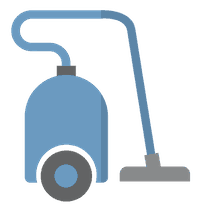Published on September 17th, 2020
Although canister vacuums are a popular choice in many European countries, the majority of users in the U.S. still opt for the more common upright model.
Not all consumers are familiar with how a canister vacuum works, which is one reason it's not the number one pick when looking for a powerful vacuum to keep your home clean.
Still, canister vacuums offer excellent cleaning power. They can be the perfect cleaning tool for homes with shedding pets and carpeted floors.
So how do you use a canister vacuum? How does it work? Let's take a look.
1. Plug in the powerful motor
Most canister vacuums are corded because a powerful motor needs a lot of power. Before you start vacuuming, you need to pull out the – usually retractable– cord and plug the vacuum to a power outlet.
The length of the power cord is crucial if you want to ensure you don't have to keep unplugging and plugging again when you move from one room to another.
2. Easily maneuver the body of the vacuum
The most noticeable feature of a canister vacuum is how it's built. The main unit contains the motor, filtration, and dust bag or dirt cup. Because the body of the vacuum sits on wheels, it can easily be pulled across floors when moving from one area to another.
This makes the machine highly maneuverable and easy to use for people who can not lift heavier objects or push and pull a big vacuum on the carpet.
In addition to adding to the usability, this configuration allows for a powerful motor. Because the motor itself does not have to be steered back and forth, it can be heavier and larger in size. This adds up to an easy-to-use yet capable vacuum cleaner with excellent cleaning performance.
3. Use the handle and hose for above-floor cleaning
The motor of the vacuum creates a powerful suction, which is then guided to the hose. This lightweight stretchable hose is connected to a handle, which you can then connect to a wand for vacuuming floors and carpets.
You can also use the handle without the rod, which allows for more careful cleaning of the above-floor items.
Usually, all the tools that come along with the vacuum can be attached to the handle piece. You can then use the crevice tool, dusting brush, or motorized brush roll on areas like the stairs, furniture, car seats, countertops, or drapes.
4. Pop on the wand to reach higher
Because the hose stretches and can be connected to the extendable wand, the canister vacuum offers excellent reach in areas that are challenging to clean.
You can use the combination to vacuum areas like the cobwebs in the corners of the ceiling, vents, window frames, and other items and surfaces that may be difficult to reach.
5. Attach the cleaning head to clean floors and carpets
You need to attach the wand and one of the cleaning heads for easily vacuuming floors and carpets. Sometimes canister vacuums come with only one attachment for all surfaces, while others have a second one designed for different floor materials.
The three main types of cleaning heads for canister vacuums are
- Multi-surface attachment with a motorized spinning brush roll you can turn on and off. This type of attachment is practical because it cleans carpets efficiently, but you can also use it on more delicate surfaces without having to change tools.
- Floor head without the brush. This tool is suitable for hardwood, parquet, tile, laminate, and such. However, although the attachment is great for hard floors, it is not very capable on carpets.
- A floor head with an air-powered brush roll. Not as good on carpets as a motorized brush roll, but better than no brush bar at all. Not ideal for finer surfaces like expensive parquet.
With a cleaning head attached to the wand, you can effortlessly guide the suction to where ever you need to clean. Under, around, and between furniture are no problem. Instead of moving the whole vacuum, you're just moving the wand and nozzle. Tight spaces are much easier to clean with a canister vacuum than a traditional one.
6. Use the controls to adjust suction and brush roll
When vacuuming with a canister vacuum, you just use the handle to steer the wand and nozzle across floors and between objects. Most vacuums have either fingertip controls on the handle or foot pedals on the main unit that you can use to adjust the suction for various surfaces and tools.
When you're done cleaning, just unplug the vacuum and use the cord retractor to pull in the cord.
7. Empty the dirt cup or dust bag
Because the configuration of a canister vacuum allows for a sizeable dirt cup or dust bag, you don't have to empty them very often.
It's more common to see canister vacuums with dust bags, which are an easy and hygienic way of disposing of the dust and dirt that end up inside the vacuum. However, we're happy to see models with dirt cups because they are easy to use, environmentally friendly, and you don't need to spend money on new dust bags.
8. Use the parking feature to store the canister vacuum
Once you're done vacuuming, you can store the vacuum away. While the traditional type of vacuum stands up on its own and is, therefore, easy to store, the canister vacuum has its benefits too.
Often, canister vacuums have a holder for the wand. It not only allows you to park the vacuum while vacuuming but also to conveniently store it when you're done. If you have a small storage space and you want the vacuum to be more compact, you can detach the wand and wrap the hose around the main body.
Summing up
How a canister vacuum works is pretty simple in the end. The main unit creates a suction, which can be guided to any area that needs to be cleaned using a hose, wand, and attachments.
The suction then pulls the dirt into the dirt cup located in the main unit, which contains the filtration system too.
The canister vacuum is easy to use and convenient because
- You don't have to push and pull the weight of the vacuum when cleaning
- Tight spaces are easier to clean because you don't have to fit a bulky vacuum between and under furniture
- The configuration allows for a powerful motor that offers good cleaning performance
So now that you know how a canister vacuum works, you can probably see why it can be an excellent choice for pet homes. Canister vacuums can offer strong suction while still being effortless to use. Also, as pet hair is known to find its way absolutely everywhere, you need a vacuum that can do the same. And a canister vacuum is definitely the ninja of the vacuum world.


